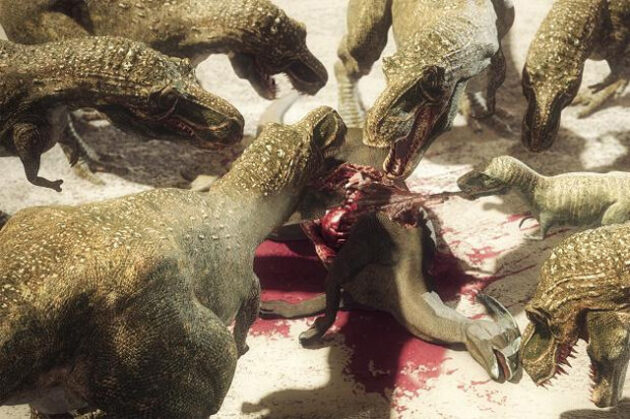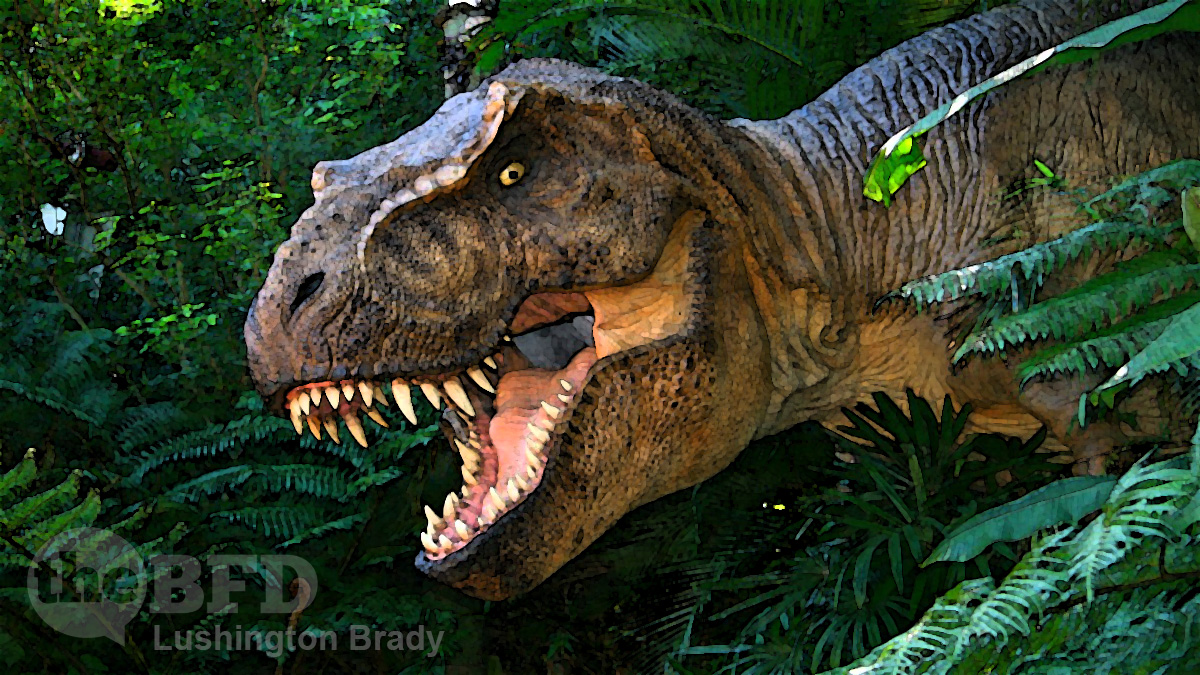Movies, from King Kong to Jurassic Park, have conditioned us to think of Tyrannosaurus rex as a solitary behemoth, stomping and screaming through the steaming jungles of primordial nightmare. A modern analogy might be the tiger – which is why Larry Niven based his nightmarish aliens, the Kzin, on tigers.
But many modern hunter animals operate in packs: lions, wolves, even humans. Jurassic Park presented its velociraptors as smaller but even scarier than its rampaging T-Rex, simply by virtue of their pack hunting techniques.
What if the real Tyrannosaurus was a horror that combined the most terrifying aspects of both?
As the most ferocious dinosaur, Tyrannosaurus rex once prowled the lands that now comprise North America with impunity. And if the conclusions of a new research project are correct, their behavior may have been even more fearsome and intimidating than previously imagined. According to an article published on April 19 in the open access journal PeerJ: Life and Environment, Tyrannosaurus rex was most likely not a solitary hunter, but instead worked in packs, to chase down, surround, and voraciously consume the animals they depended on for sustenance, much like wolves.

One issue with the Jurassic Park picture of the T-Rex thundering after its fleeing prey like a gigantic, lizard-y cheetah is its sheer size. The ineluctable laws of physics mitigate against such a gigantic creature racing after a fleeing jeep.
The biggest problem with trying to piece together the past from the fossil record is that fossilisation is such a rare event. Worse, it tends to favour certain types of environments and circumstances. Unless a dead organism is quickly buried in an oxygen-depleted environment and safely away from scavengers, it’s extremely unlikely to last long enough to be fossilised.
Occasionally, though, circumstances favour the modern-day tomb-raiders.
The scientists performed an extensive analysis of a diverse collection of Tyrannosaurus rex bones found at a fecund Cretaceous-period fossil site in southern Utah , which is located near the Grand Staircase-Escalante National Monument. This site is known colloquially as the “Rainbows and Unicorns Quarry,” in recognition of all the rare fossils (the “unicorns”) that have been unearthed there.
Paleontologist Alan Titus, who discovered the Rainbows and Unicorns site in 2014 and is one of the lead authors of the PeerJ study, says that the group of deceased and fossilized Tyrannosaurus rex specimens were the victims of a massive flood that drowned them and washed their bodies into a lake. They lay on the bottom, grouped together and undisturbed, for millions of years.
So what does this site tell us? Tentatively, that tyrannosaurs had more in common with lions and wolves than tigers and cheetahs.
The members of the BLM research team see their findings as offering indirect but clear evidence of group dynamics in action among the Tyrannosaurus rex specimens in question[…]
“The new Utah site adds to the growing body of evidence showing that tyrannosaurs were complex, large predators capable of social behaviors common in many of their living relatives, the birds,” said research project participant Joe Sertich.
If that didn’t make the gigantic tyrannosaurs scary enough, it’s likely that they behaved much like another staple of human nightmares: the Implacable Hunter.
It can’t be bargained with. It can’t be reasoned with. It doesn’t feel pity, or remorse, or fear. And it absolutely will not stop, ever, until you are dead.
The Terminator
We’ve seen them in countless movies and even our own nightmares: the slow, steady, relentless hunter who, no matter how fast you run, is always doggedly there.
Contrary to previous assertions, which claimed Tyrannosaurus rex could travel at speeds of up to 42 miles (70 kilometers) per hour, the Canadian researchers concluded that a sprinting T. rex wouldn’t have been able to top the 12-mile-per-hour (20-kilometer-per-hour) mark. The T. rex anatomy would have allowed them to keep going at that speed for considerable distances, however, according to McGill University professor Hans Larsson.
And in case you’re still thinking of building that time machine, consider this:
After crunching all the numbers, the Cal-Berkeley team determined that there would have been approximately 20,000 individual animals living on the 1.4 million square miles (2.3 million square kilometres) of available habitat space at any one time […] If they travelled in groups of 10 to 20, between one and two thousand T. rex packs would have been roaming the continent searching for food at any given time.
Ancient Origins
Pandemics and all, 2021 is looking pretty safe by comparison.
Please share this article so that others can discover The BFD

